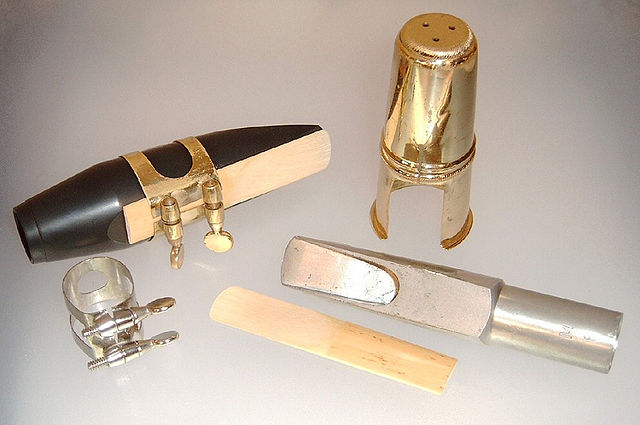In order to make the best sound with your saxophone, you need to pay attention to the mouthpiece you use. The saxophone mouthpiece helps to create all the different tones in your saxophone and you must think carefully about what type of sax sound is the right for you. When it comes to buying a mouthpiece for a saxophone, the following things are the most important to keep in mind.
 “Mouthpiece tenor saxophone”. Licensed under Creative Commons Attribution-Share Alike 3.0 via Wikimedia Commons
“Mouthpiece tenor saxophone”. Licensed under Creative Commons Attribution-Share Alike 3.0 via Wikimedia Commons
Selecting the Material
There are plenty of different options when it comes to picking the material of your mouthpiece. Currently you can find saxophone mouthpieces in plastic, metal and hard rubber and sometimes even in a combination of these.
The most common choice is to go with a plastic mouthpiece. If there is one downside to selecting plastic as your favoured material, it is its tendency to break up easily and the structure might lose its form much quicker. For a more durable option, hard rubber is good to keep in mind, especially for beginners.
Furthermore, if you are passionate about jazz music, then a metal mouthpiece provides the clearest and brightest sound. A number of jazz musicians recommend Jody Jazz saxophone mouthpieces, which you can buy at Dawkes.co.uk.
Differences in Opening and Tone Chamber
For beginners, the opening of the mouthpiece is also a key criterion for buying the right mouthpiece. Opening is the distance between the top of the mouthpiece to the tip of the reed. Depending on the distance, your saxophone will make a specific sound.
If the opening is very narrow, the tone is very clear. On top of this, a narrow opening is also a bit easier to play and could be a great choice for beginner saxophone players. Naturally, if you are looking for a stronger, higher volume, then a wider opening will help you achieve this.
Another crucial factor changing the tone is the tone chamber. If you are looking for a lower tone sound, then you want to go with a larger mouthpiece chamber.
Keep in Mind Ligature and the Facing Length
On top of the above, two further aspects influence your mouthpiece selection process. The first one is the ligature, which is the little device that keeps the reed attached to the mouthpiece. In fact, as you can read from this Neff Music blog post, the ligature can influence the sound of your saxophone quite a great deal. Rubbery ligatures are often the best and most durable options to keep in mind.
Finally, the facing length of the mouthpiece can also influence the tone. For a low sound, you want to go with longer facing lengths to further emphasise the tone. Furthermore, if you are looking for tips on how to look after your mouthpiece, you should check out SHWoodwind.co.uk.
Hopefully, the above tips will help you find the best possible mouthpiece for your saxophone. If you can, then try out different mouthpieces before purchase. This way, you can pick the one that suits your play style as well as creates the kind of sound you want to make.
Are you a guitarist? Check out our full range of online guitar lessonsAre you a saxophonist? Check out our full range of online saxophone lessons
Subscribe to Pro Music Tutor from as little as £7.99 per month
Related Posts
-
Breaking Down the Blues Scale for Saxophone
The blues and the saxophone go hand-in-hand, but mastering the techniques of the blues scale can take practise and patience. The blues scale is an excellent tool for improvisation and is a great stepping stone to creating your own compositions. It also enables you to play with other musicians without the need to be following […]
View All >> -
NEW RELEASE: Roberto Manzin’s Latin Improvisation Series 1
We’re delighted to announce the release of the brilliant Roberto Manzin’s first set of online saxophone lessons here at Pro Music Tutor with the launch of Latin Improvisation Series 1. Roberto Manzin is one of the world’s leading saxophonists, and in Latin Improvisation Series 1 you can learn some of the great tips and techniques […]
View All >>
Latest Blog Entries
-
The Benefits of Online Music Education
Learning music has never been easier, since the internet and modern technological advancements have opened the doors to countless possibilities, expanding the subjects people can choose from and how the lessons are taught. Now, people can study a whole host of music-related topics; from learning to play guitar or DJing, to understanding the inner workings […]
View All >> -
Essential Jazz Guitar Scales that are Easy to Learn
Improvising in jazz requires the ability to play in different keys over different chords. Results certainly do not come overnight, but with diligent practice, you would be surprised by what you can achieve. Many people ask me about what scales I use as if they were some big secret. While knowing your scales is very […]
View All >>
Blog Categories
- Categories
- Guitar Tips (93)
- History (36)
- How-To (38)
- Interviews (3)
- Music Industry (121)
- Prolinks Guitar (2)
- Prolinks Lessons (3)
- Prolinks Tutor's Profile (1)
- Saxophone Tips (40)
- Uncategorized (6)
Tags
Archive
- November 2018 (1)
- February 2018 (1)
- December 2017 (1)
- November 2017 (1)
- October 2017 (1)
- July 2017 (4)
- May 2017 (2)
- April 2017 (1)
- August 2016 (2)
- July 2016 (1)
- June 2016 (2)
- May 2016 (3)

